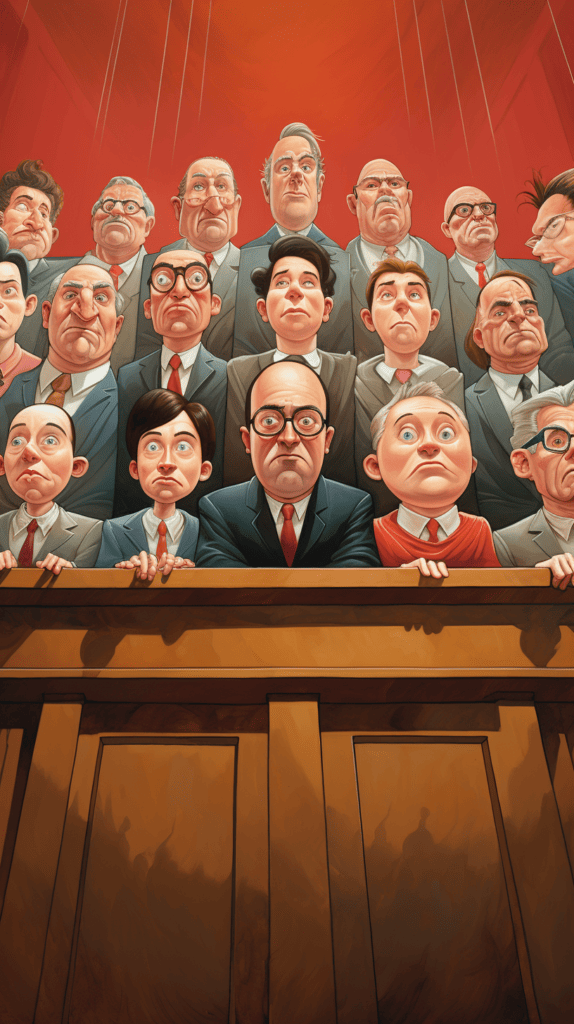In a world that thrives on diversity of thought and opinion, understanding the dynamics that shape our beliefs and attitudes is essential. One fascinating phenomenon that plays a pivotal role in how ideas and attitudes evolve within groups is group polarization.
Group polarization is the process by which individual members of a group make decisions that are more extreme than the average of the group's initial attitudes or opinions. This means that if a group initially leans towards a particular viewpoint, discussion within the group tends to intensify this stance, pushing members towards a more extreme position.
Exploring this concept will shed light on its historical background, the mechanisms that drive it, its impact on various facets of society, and ways in which it can be navigated and counteracted. This exploration aims to be an insightful journey through the intricate pathways of social dynamics, blending theories, real-world instances, and reflections for a mature, yet accessible discourse.
History of Group Polarization

The concept of group polarization isn’t a recent discovery in the world of social psychology; it has intrigued minds and shaped theories for several decades. The initial seeds were sown in the early 1960s when an American psychologist, James Stoner, stumbled upon this phenomenon while studying “risky shift”.
Stoner found that when people were part of a group, they made decisions that were riskier compared to those made individually. This was the first instance where the amplification of group opinion was formally observed and studied, marking a significant milestone in understanding group dynamics.
Following Stoner’s experiment, researchers utilized the Choice Dilemma Questionnaire to further explore this intriguing phenomenon. This tool helped measure shifts in attitudes before and after group discussions, allowing a deeper insight into how group interactions can sway individual opinions.
Through countless studies and experiments using such tools, it became evident that it wasn’t just riskiness that could be amplified, but any attitude or opinion could become more extreme within a group setting.
This revelation broadened the scope of group polarization research and set the stage for a myriad of studies and theories.
As years rolled on, the understanding of group polarization evolved and expanded. Researchers and theorists delved deeper, exploring various factors contributing to this phenomenon.
Two significant theories emerged: the Social Comparison Theory, developed by Leon Festinger, and the Persuasive Arguments Theory, formulated by David Myers and Carolyn L. Hogg.
Festinger proposed that individuals, when in a group, tend to compare their opinions with others and adopt more extreme positions to align with the group norm. Myers and Hogg, on the other hand, suggested that exposure to new and persuasive arguments during group discussions can lead individuals to adopt more extreme viewpoints.
Alongside these theoretical developments, real-world instances of group polarization started to gain attention. Observations were made in different societal setups, from political campaigns to jury decisions, highlighting the pervasive nature of this phenomenon.
The advent of the internet and social media platforms further added a new dimension to group polarization studies, as virtual groups and online communities became breeding grounds for more extreme opinions.
In essence, the journey of understanding group polarization has been marked by a rich tapestry of studies, theories, and observations.
From the early experiments of James Stoner to the nuanced theories of Festinger, Myers, and Hogg, and the ongoing studies in our digitally connected world, group polarization continues to be a crucial element in unraveling the complexities of human interaction and societal dynamics.
Understanding Group Polarization
To delve into the intricacies of group polarization, it’s crucial to unravel the mechanisms that fuel this phenomenon.
Imagine a group of friends discussing a topic they all feel moderately passionate about. As the conversation flows, you might notice the viewpoints becoming more intense, the opinions more defined. This amplification is at the heart of group polarization.
What Happens During Group Polarization?
During group polarization, individual members tend to adopt a more extreme position than their initial stance. This shift occurs as members are influenced by the prevailing sentiment of the group.
Let’s paint a picture with a simple example: if a group of students is mildly in favor of a longer school day for extra-curricular activities, after discussions, they might end up strongly advocating for it, with their opinions becoming more pronounced and extreme.
Factors Leading to Group Polarization
Digging deeper, two primary theories help explain why this intensification occurs: Social Comparison Theory and Persuasive Arguments Theory.
Leon Festinger’s Social Comparison Theory posits that individuals have an inherent desire to fit in and be accepted by their peers. When in a group, people tend to compare their viewpoints with others, and in an effort to be seen favorably, they might adopt a more extreme stance that aligns with the group norm.
On the other hand, David Myers and Carolyn L. Hogg’s Persuasive Arguments Theory offers a different perspective. This theory suggests that group discussions expose individuals to new and persuasive arguments, which can sway their opinions further in the direction of the group’s initial stance.
In essence, the more arguments one hears supporting a particular viewpoint, the more likely they are to adopt a more extreme position.
Influence of Social Media
Fast forward to the digital age, and the landscape of group polarization takes on new contours. Social media platforms amplify this phenomenon by connecting like-minded individuals and creating echo chambers where similar opinions reverberate.
On platforms like Facebook or Twitter, algorithms are designed to show content that aligns with users’ existing beliefs, further entrenching their viewpoints and fostering group polarization.
This digital evolution adds layers of complexity to our understanding, as online interactions facilitate the rapid spread and intensification of ideas and opinions.
Real-world instances like online debates on climate change or discussions on community forums showcase the pervasive nature of group polarization in our interconnected society.
The digital realm magnifies this phenomenon, as people from different corners of the world can come together, share their views, and in the process, shape and intensify each other’s opinions.
Understanding the mechanism of group polarization involves peeling back the layers of human interaction, social comparison, persuasive arguments, and the influence of the digital world.
It’s a journey through the corridors of group dynamics, where individual viewpoints are shaped, molded, and intensified, painting a vivid tableau of the collective human psyche.
Impact of Group Polarization on Society

Exploring the ripple effects of group polarization reveals its extensive imprint on the fabric of society. This phenomenon doesn’t just reside in academic papers or controlled experiments; it breathes life in political arenas, communities, and marketplaces, shaping the ebb and flow of human interaction and decision-making.
Political Implications
In the realm of politics, group polarization often takes center stage. Political parties and their supporters, initially having moderate stances, can veer towards more extreme positions after internal discussions and debates.
For instance, during election campaigns, party members and followers often find their views becoming more radicalized, which can further polarize the general population. This polarization is evident in various elections worldwide, where political discourse has become increasingly divided, and middle-ground opinions are harder to come by.
Social Implications
On a social level, group polarization molds communities and relationships. When like-minded individuals cluster together, their shared beliefs and values are intensified, potentially leading to a lack of understanding and tolerance for differing viewpoints.
Confirmation bias, the tendency to favor information that confirms one’s existing beliefs, plays a pivotal role here. It acts as a catalyst, further deepening the divide between different social groups and fostering an environment where mutual respect and dialogue can be challenging to sustain.
Economic Implications
The marketplace is not immune to the influences of group polarization. Consumer behavior and brand loyalties can be significantly swayed as individuals within a group lean towards more extreme preferences.
A clear illustration of this is seen in brand rivalries, where consumers of competing brands, such as Apple and Samsung, often exhibit intensified brand loyalty after interacting with like-minded peers. This polarization in the market can influence advertising strategies, product development, and overall market dynamics.
In conclusion, the impact of group polarization on society is multi-faceted and profound. It’s like a subtle current, guiding the course of political landscapes, social interactions, and economic ecosystems.
Recognizing its presence and understanding its implications are essential steps in fostering a society that values diversity, encourages dialogue, and seeks unity amidst differences.
Examples of Group Polarization

Group polarization, while a broad and overarching concept, manifests itself distinctly in varied scenarios. Several notable instances highlight the diverse ways this phenomenon shapes outcomes and influences societal structures.
From the solemnity of jury rooms to the fervent atmosphere of political campaigns and the digital forums of the internet, group polarization leaves indelible marks.
1) Group Polarization in Jury Decision-Making: The Rodney King Trial
The 1992 trial of Rodney King was a watershed moment in American judicial history.
Rodney King, an African American motorist, experienced excessive force by Los Angeles police officers, and the incident was captured on video, sparking outrage nationwide.
During the trial, the jury was tasked with determining the guilt of the officers involved. The initial discussions within the jury were marked by varying opinions. However, as deliberations progressed, group polarization became evident.
The jurors leaned towards more extreme positions, ultimately leading to the acquittal of the officers. The verdict ignited widespread civil unrest, highlighting the profound societal implications of group polarization within a jury setting.
2) Political Elections and Campaigns: The 2016 United States Presidential Election
The 2016 United States Presidential Election between Donald Trump and Hillary Clinton was a glaring display of group polarization.
Both supporters of Trump and Clinton became increasingly entrenched in their political views as the campaign progressed. Social media platforms and news outlets played a significant role in this polarization.
Algorithms on platforms like Facebook and Twitter created echo chambers by showing users content that aligned with their existing beliefs, intensifying pre-existing biases. The election outcome, marked by stark divisions and heightened emotions, showcased the impact of group polarization on political discourse and electoral dynamics.
3) Online Communities and Forums: The Dynamics on Reddit
Reddit, a popular online platform, offers a myriad of subreddits dedicated to specific interests, beliefs, or ideologies. Within these subreddits, group polarization is frequently observed.
For instance, within technology-related subreddits, discussions about the merits of different operating systems or hardware can lead to more extreme and entrenched positions.
A user mildly favoring one type of technology might, after interacting with like-minded users and engaging in discussions, develop a strong preference and dismiss competing technologies.
Similarly, subreddits focused on social or political issues often see users' views intensify, leading to the formation of online movements and campaigns, and sometimes even translating to real-world actions and protests.
Further Examples
4) Brexit Vote (2016)
The UK’s referendum on EU membership witnessed significant group polarization, with both ‘Leave’ and ‘Remain’ camps intensifying their stances, leading to a deeply divided public opinion.
5) Vaccination Debates
Discussions around vaccinations have seen group polarization, with pro-vaccine and vaccine-hesitant groups becoming more entrenched in their beliefs through internal discussions and information sharing.
6) Climate Change Discussions
Group polarization is evident in climate change debates, with climate activists and climate change skeptics often becoming more steadfast in their views after group interactions.
7) Gun Control Debate in the USA
The ongoing discourse on gun control sees individuals within pro-gun and gun-control advocacy groups solidifying and intensifying their respective positions.
8) Social Media Influencer Culture
Followers of specific influencers on platforms like Instagram can exhibit group polarization, developing stronger affinities or aversions to trends, products, or values promoted by the influencer.
9) Sports Team Rivalries
Fans of rival sports teams often experience group polarization, leading to intensified loyalty and animosity, especially during competitive events.
10) College Fraternities and Sororities
Members of college fraternities and sororities can exhibit group polarization in their attitudes towards social events, group values, and inter-group relations.
11) Religious Extremism
Within certain religious sects or groups, discussions and shared beliefs can lead to intensified views and, in extreme cases, radicalization.
12) Corporate Culture
Employees within a company can develop more extreme attitudes towards workplace practices, policies, or corporate ethics through group interactions.
13) Consumer Brand Loyalty
Discussions among brand enthusiasts, such as car enthusiasts, can lead to strengthened brand loyalty and dismissal of competing brands.
14) Gentrification Debates
In discussions about urban development, groups can polarize into strongly pro-gentrification or anti-gentrification stances.
15) Educational Pedagogy Discussions
Educators and parents can polarize on issues like standardized testing or homeschooling, leading to intensified advocacy for or against these practices.
16) Veganism vs. Meat-Eating Debates
Dialogues around dietary choices often result in group polarization, with vegans and meat-eaters becoming more convicted in their dietary philosophies.
17) Tech Platform Wars
Supporters of different technology platforms (e.g., iOS vs. Android, PC vs. Mac) often intensify their preferences and aversions through group discussions.
18) Discussions on Economic Theories
Economists and students can polarize around different economic theories (e.g., Keynesian vs. Classical) through academic discussions and debates.
19) French Revolution (1789–1799)
During the French Revolution, group polarization played a crucial role as revolutionaries and monarchists became increasingly entrenched in their respective beliefs, leading to radical actions and societal upheaval.
20) Anti-Vaccination Movements
Group polarization is evident in anti-vaccination movements, where like-minded individuals reinforce each other's skepticism about vaccines, often leading to the spread of misinformation and heightened resistance to vaccination.
21) Feminist Movements
The various waves of feminist movements have witnessed group polarization, with advocates and opponents of gender equality becoming increasingly steadfast in their views through group interactions.
22) Prohibition in the United States (1920–1933)
The era of Prohibition saw significant polarization between temperance advocates and opponents, leading to intensified campaigns, law enforcement efforts, and the rise of illegal activities.
23) Civil Rights Movement (1950s and 1960s)
The struggle for racial equality in the United States showcased group polarization, with civil rights activists and segregationists becoming more entrenched in their beliefs and actions.
24) Nuclear Energy Debates
Discussions surrounding the use of nuclear energy have led to group polarization, with proponents and opponents solidifying their stances on its risks and benefits.
25) Flat Earth Conspiracies
Within flat earth conspiracy communities, group polarization occurs as members reinforce each other’s beliefs, leading to the dismissal of scientific evidence and mainstream viewpoints.
26) Video Game Console Wars
Fans of different video game consoles, such as PlayStation and Xbox, often exhibit group polarization, intensifying their preferences and engaging in heated debates.
27) Genetically Modified Organisms (GMOs) Debates
The discourse around GMOs has seen proponents and opponents of genetically modified crops become increasingly polarized in their views on safety and ethical considerations.
28) Immigration Policy Debates
Discussions on immigration policies across various countries have showcased group polarization, with people becoming more steadfast in either pro-immigration or anti-immigration stances.
29) Healthcare Reform Discussions
Debates around healthcare reforms, such as the Affordable Care Act in the United States, have led to increased polarization between supporters and detractors of different healthcare models.
30) Cannabis Legalization Debates
Conversations about the legalization of cannabis often result in group polarization, with proponents and opponents solidifying their arguments and advocacy efforts.
31) Animal Rights Movements
Group polarization is evident in animal rights movements, where activists and opponents intensify their views on animal welfare and the ethics of animal use.
32) Discussions on Artificial Intelligence (AI) Ethics
The debate on AI ethics sees technologists, ethicists, and the general public polarize on the risks and benefits of implementing AI in various sectors.
33) Public Education vs. Homeschooling Debates
Parents and educators often become polarized in their views on the merits of public education versus homeschooling, leading to intensified advocacy for their preferred approach.
34) Globalization Debates
Discussions on globalization lead to group polarization, with individuals becoming more entrenched in their views on the benefits and drawbacks of global economic integration.
35) Body Positivity Movement
The body positivity movement has led to polarization between advocates of body acceptance and those who argue for the importance of addressing health concerns related to body weight.
36) Cultural Appropriation Discussions
Conversations around cultural appropriation see individuals polarize into groups defending cultural exchange and those advocating for the protection of marginalized cultures.
37) Debates on Police Funding
The discourse on police funding, especially in the wake of movements like Black Lives Matter, has seen communities polarize on issues of police reform and funding allocations.
38) Space Exploration Funding Debates
Discussions around funding for space exploration often result in polarization between those who view it as essential for scientific advancement and those who argue for prioritizing earthly concerns.
Counteracting Group Polarization

Addressing the challenges posed by group polarization requires a multifaceted approach.
In recognizing the influences that lead to extreme stances, society can implement strategies aimed at fostering open dialogue, enhancing mutual understanding, and encouraging a more balanced perspective.
Encouraging Diverse Viewpoints
One of the foundational steps in counteracting group polarization is to encourage the inclusion of diverse viewpoints within group discussions.
By ensuring that a range of opinions and perspectives are represented, groups can avoid the echo chamber effect and promote a more balanced and nuanced conversation. This diversity enables members to be exposed to different arguments, which can mitigate the intensification of initial stances.
Fostering Critical Thinking
Cultivating critical thinking skills is another vital strategy. Encouraging individuals to question assumptions, evaluate evidence, and consider alternative perspectives can lead to more informed and balanced opinions.
Educational institutions play a crucial role in fostering these skills, by integrating critical thinking exercises and promoting reflective practices within the curriculum.
Role of Moderators and Facilitators
In both online and offline discussions, the presence of a moderator or facilitator can help manage the conversation and ensure that a variety of opinions are heard.
By preventing dominant voices from overshadowing others and steering the discussion towards constructive dialogue, moderators can help counteract the tendencies towards polarization.
Digital Literacy and Social Media Awareness
In the age of digital communication, educating individuals about the workings of social media algorithms and the creation of online echo chambers is essential.
Raising awareness about how online platforms can reinforce existing beliefs and filter out dissenting views can empower users to seek out diverse information sources and challenge their own viewpoints.
Promoting Empathy and Understanding
Fostering a sense of empathy and understanding is fundamental in bridging divides. Encouraging individuals to appreciate the experiences and perspectives of others, even if they disagree, can lead to more respectful and constructive conversations.
Activities and programs that facilitate intergroup contact and mutual understanding can contribute to reducing polarization.
Reflecting on Personal Biases
Encouraging self-reflection on personal biases and preconceptions can lead to a deeper understanding of one’s own stance and a greater openness to alternative viewpoints. Mindfulness and reflective practices can aid individuals in recognizing their biases and approaching discussions with a more open and balanced mindset.
Counteracting group polarization is a collective effort that involves fostering diversity of thought, cultivating critical thinking, raising digital literacy, and promoting empathy and self-reflection.
Through these strategies, society can work towards more balanced and constructive group dynamics, mitigating the risks associated with polarization and promoting a more inclusive and harmonious community.
Conclusion
Group polarization is a fascinating and pervasive social phenomenon where discussions within a like-minded group lead to the amplification of the group's initial attitudes.
From the hallowed halls of justice in the Rodney King trial to the tumultuous political landscapes during the 2016 U.S. Presidential Election, and within the digital realms of platforms like Reddit, the fingerprints of group polarization are evident.
The diverse array of examples highlights the varied contexts in which this phenomenon manifests and underscores its profound implications on societal structures, norms, and decisions.
However, acknowledging the presence and impact of group polarization is the first step towards addressing its challenges. By fostering environments that encourage diverse viewpoints, promoting critical thinking, enhancing digital literacy, and cultivating empathy and self-reflection, society can work towards mitigating the risks associated with this phenomenon.
The strategies outlined for counteracting group polarization serve as a roadmap, guiding individuals and communities towards more balanced and constructive dialogues.
In a world where opinions are increasingly polarized and echo chambers are ever-present, understanding and addressing group polarization is not just an academic exercise, but a societal imperative.
It calls for collective self-awareness, mutual respect, and a commitment to embracing diversity of thought. In doing so, society can navigate the complexities of group dynamics, champion inclusivity, and foster a sense of unity in the face of diversity.
Through intentional effort and thoughtful discourse, the tide of group polarization can be tempered, paving the way for a more harmonious and understanding world.



